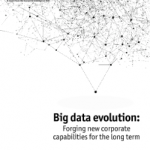 In my two prior posts, I discussed the process of developing a business justification for a data strategy and for assessing an organization's level of maturity with key data management processes and operational procedures. The business justification phase can be used to speculate about the future state of data management required to meet existing and potential future needs. The assessment phase establishes where your organization is in terms of data management practices.
In my two prior posts, I discussed the process of developing a business justification for a data strategy and for assessing an organization's level of maturity with key data management processes and operational procedures. The business justification phase can be used to speculate about the future state of data management required to meet existing and potential future needs. The assessment phase establishes where your organization is in terms of data management practices.
The gaps between where your organization wants to be in the future and where it is today can be formulated into the first cut of a laundry list of desired outcomes. In turn, a data strategy must suggest how introducing new data management practices, improving existing practices, and socializing the necessary changes in the ways that individuals consider, treat and manage data will not only alleviate the noted gaps, but will also deliver quantifiable value. Concretely, this means devising an information environment of the future. That is, an environment with the capacity, performance and functionality to meet existing and anticipated business needs, and to demonstrably lead to value creation or improvement. Correspondingly, the data strategy layers the implementation of data management practices on top of the proposed environment in ways that are directly tied to business objectives.
As an example, consider an organization that wants to implement customer profiling and analytics to increase sales volumes. Note that this objective blends a data management practice (customer profiling and analytics) with a business objective (increasing sales volume). By attaching a quantifiable business objective to the technical directive, we provide a natural metric to assess the success of the strategy.

Hopefully, the assessment phase will highlight gaps in the existing data management landscape that inhibit customer profiling and analytics. This allows you to speculate as to what technologies and practices you should consider as part of your future data management landscape to enable customer profiling. Perhaps it will include master customer data management, a customer data warehouse, integration tools for ingesting and integrating customer data, federation tools for provisioning customer data, analytics tools for analysis, etc.
You can repeat this exercise for each of your business objectives, allowing you to link each proposed change in the data environment to a business driver. In the end, the proposed set of data management technologies and practices can be collated, organized and prioritized as part of a business-oriented data strategy.





